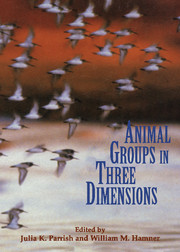Book contents
- Frontmatter
- Contents
- List of contributors
- Acknowledgments
- 1 Introduction – From individuals to aggregations: Unifying properties, global framework, and the holy grails of congregation
- Part one Imaging and measurement
- Part two Analysis
- 7 Quantitative analysis of animal movements in congregations
- 8 Movements of animals in congregations: An Eulerian analysis of bark beetle swarming
- 9 Individual decisions, traffic rules, and emergent pattern in schooling fish
- 10 Aggregate behavior in zooplankton: Phototactic swarming in four developmental stages of Coullana canadensis (Copepoda, Harpacticoida)
- Part three Behavioral ecology and evolution
- Part four Models
- References
- Subject index
- Taxonomic index
9 - Individual decisions, traffic rules, and emergent pattern in schooling fish
from Part two - Analysis
Published online by Cambridge University Press: 01 June 2010
- Frontmatter
- Contents
- List of contributors
- Acknowledgments
- 1 Introduction – From individuals to aggregations: Unifying properties, global framework, and the holy grails of congregation
- Part one Imaging and measurement
- Part two Analysis
- 7 Quantitative analysis of animal movements in congregations
- 8 Movements of animals in congregations: An Eulerian analysis of bark beetle swarming
- 9 Individual decisions, traffic rules, and emergent pattern in schooling fish
- 10 Aggregate behavior in zooplankton: Phototactic swarming in four developmental stages of Coullana canadensis (Copepoda, Harpacticoida)
- Part three Behavioral ecology and evolution
- Part four Models
- References
- Subject index
- Taxonomic index
Summary
Introduction
Schools of fish are one of the most studied and best known of all animal congregations (see Pitcher & Parrish 1993). Over 25% of the world's fish school throughout their lives, and over 50% school as juveniles (Shaw 1978). Behavioral and evolutionary studies of schooling fish have indicated that group membership is more advantageous than a solitary existence. Group members may incur a lower risk of predation (Turner & Pitcher 1986; Magurran 1990; Romey Ch. 12), have greater access to food resources (Street & Hart 1985; Ryer & Olla 1992), and expend less energy swimming (Zuyev & Belyayev 1970; Weihs 1973, 1975). Regardless of the reason, most studies assume that membership in a stable congregation is beneficial to the individual. This positive cost to benefit ratio is then used as an argument for both the evolution (Hamilton 1971; Mangel 1990) and maintenance (Parrish 1992) of aggregative behavior in fish. However, as with the study of congregation in general, mechanistic approaches to the study of fish schooling have lagged behind functional approaches. While we may have a good idea why fish congregate, we know relatively little about how fish congregate, let alone form polarized schools of synchronously responding individuals.
Traditionally, schools have been defined by a polarized orientation of the individuals, regardless of whether the school itself is moving or stationary (see Pitcher & Parrish 1993). Thus it is easy to imagine a congregation of fish slipping into, and out of, a schooling configuration, while still maintaining the same group boundaries, volume, shape, and even relative position of the individual members.
- Type
- Chapter
- Information
- Animal Groups in Three DimensionsHow Species Aggregate, pp. 126 - 142Publisher: Cambridge University PressPrint publication year: 1997
- 24
- Cited by



